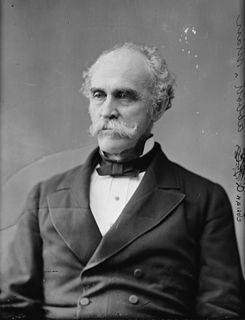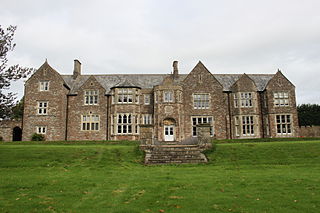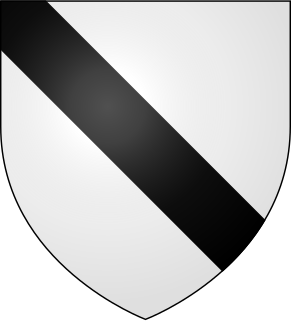Related Research Articles

Josiah Gardner Abbott was an American politician who served in the Massachusetts General Court and as a member of the United States House of Representatives from Massachusetts.
Strachey is a surname. Notable people with the surname include:

Tormarton is a village in South Gloucestershire, England. Its name may come from Thor Maer Tun meaning The settlement with the thorn (tree) on the boundary. Another source suggests the name derives from the church tower (Tor) on the border between Wessex and Mercia. It is one mile North-East of junction 18 of the M4 motorway, with the A46 road and close to the border between Wiltshire and South Gloucestershire. In 2001 and 2011 there were 144 households and the population was 348. A National Trail, the Cotswold Way passes through the village. There is a church, a hotel, a pub and also a number of bed and breakfasts in the village. A Highways Agency depot with a salt dome is situated near to the village.

Stowey is a small village within the Chew Valley in Somerset, England. It lies south of Chew Valley Lake and north of the Mendip Hills, approximately 10 miles (16 km) south of Bristol on the A368 road Weston-super-Mare to Bath. Stowey and its neighbouring and larger village, Bishop Sutton, form the civil parish of Stowey Sutton.

Sir Francis Knollys, KG of Rotherfield Greys, Oxfordshire was an English courtier in the service of Henry VIII, Edward VI and Elizabeth I, and was a Member of Parliament for a number of constituencies.

Sutton Court is an English house remodelled by Thomas Henry Wyatt in the 1850s from a manor house built in the 15th and 16th centuries around a 14th-century fortified pele tower and surrounding buildings. The house has been designated as Grade II* listed building.
Edward St. Loe Livermore, son of Samuel Livermore and brother of Arthur Livermore, was a United States Representative from Massachusetts. He was born in Portsmouth in the Province of New Hampshire on April 5, 1762. Livermore pursued classical studies, studied law, was admitted to the bar and commenced practice in Concord, New Hampshire and later practised in Portsmouth.
The office of High Sheriff of Somerset, until 1974 called Sheriff of Somerset, is an ancient shrievalty which has been in existence for over one thousand years.
Sir James Harington of Exton was a 16th-century English public servant who fulfilled a number of legal, legislative and law enforcement duties and was knighted in 1565.

Sir Henry Strachey, 1st Baronet was a British civil servant and politician who sat in the House of Commons for 39 years from 1768 to 1807.

The Church of St Andrew in Chew Magna, Somerset, England dates from the 12th century with a large 15th-century pinnacled sandstone tower, a Norman font and a rood screen that is the full width of the church. It is a Grade I listed building.

Sir William St Loe (1518–1565) was a 16th-century English soldier, politician and courtier. He was the third husband of Bess of Hardwick, his second wife. His official positions included Captain of the Yeomen of the Guard, Chief Butler of England and Member of Parliament for Derbyshire.

The House of Gorges is an ancient English family with Norman origins. They obtained the manors of Wraxall, Somerset and Bradpole in Dorset. The family again reached prominence in the 16th and 17th centuries.

Sir Maurice Denys (1516–1563) of Siston Court, near Bristol, Gloucestershire, and of St John's Street, Clerkenwell, Middlesex, was an English lawyer and property speculator during the Dissolution of the Monasteries, at which time he served as a "powerful figure at the Court of Augmentations". He served as a Member of Parliament for Malmesbury in Wiltshire and as Treasurer of Calais. He was the builder of Siston Court in Gloucestershire, which survives largely unaltered since his time. His excessive speculation and borrowing caused the ruination of the Siston branch of the Denys family.

Sir Thomas Leighton was an English soldier and politician. He served as the Governor of Guernsey and Jersey from 1570 to 1609.
William Brereton, 3rd Baron Brereton FRS was an English mathematician and politician who sat in the House of Commons in 1659 and became Baron Brereton in the Irish peerage in 1664. He was chairman of the Committee of Accounts, better known as the Brooke House Committee, in 1667–1670. In that capacity he clashed repeatedly with Samuel Pepys, whose description of Brereton in his Second Diary, or Brooke House Journal, although no doubt biased, is the best portrait we have of the man.

Reverend William Helyar, Doctor of Divinity, of Coker Court, East Coker, in Somerset, was Archdeacon of Barnstaple and a chaplain to Queen Elizabeth I.

The Admiralty and Marine Affairs Office (1546-1707) originally known as the Admiralty Office (1414-1546) was a government office of the Kingdom of England and the English Navy's central command. It was first established in 1414 when the remaining regional admiralties, the Northern and Western were abolished and their functions were unified under a single centralized command. It was administered by the Office of the High Admiral of England, Ireland and Aquitaine later called the Lord Admiral of England. During the sixteenth century it oversaw the creation of standing "Navy Royal", with its own secretariat, dockyards and a permanent core of purpose-built warships, originated in the early 16th century during the reign of Henry VIII. Under Elizabeth I England became involved in a war with Spain, which saw privately owned ships combining with the Royal Navy in highly profitable raids against Spanish commerce and colonies. In 1588, Philip II of Spain sent the Spanish Armada against England to end English support for Dutch rebels, to stop English corsair activity and to depose the Protestant Elizabeth I and restore Catholicism to England. The Spaniards sailed from Lisbon, planning to escort an invasion force from the Spanish Netherlands but the scheme failed due to poor planning, English harrying, blocking action by the Dutch, and severe storms. A Counter Armada, known as the English Armada, was dispatched to the Iberian coast in 1589, but failed to drive home the advantage England had won upon the dispersal of the Spanish Armada in the previous year. The Admiralty of England existed until 1707 when Kingdom of England and the Kingdom of Scotland united to form the single Kingdom of Great Britain when it then became known as the Admiralty Department or Admiralty of Great Britain.

The Admiral of the Narrow Seas also known as the Admiral for the guard of the Narrow Seas was a senior Royal Navy appointment. The post holder was chiefly responsible for the command of the English navy's Narrow Seas Squadron also known as the Eastern Squadron that operated in the two seas which lay between England and Kingdom of France and England and the Spanish Netherlands later the Dutch Republic from 1412 to 1688.. His subordinate units, establishments, and staff were sometimes informally known as the Command of the Narrow Seas.
References
- ↑ "ST. LOE (SEYNTLOWE), Edward (d.1578), of Sutton Court, Som. and Knighton, Wilts. - History of Parliament Online". Historyofparliamentonline.org. Retrieved 10 March 2019.
| This article about a 16th-century Member of the Parliament of England is a stub. You can help Wikipedia by expanding it. |